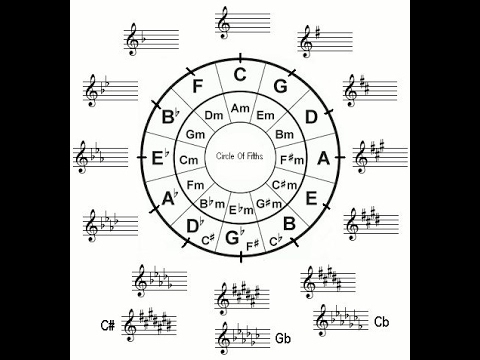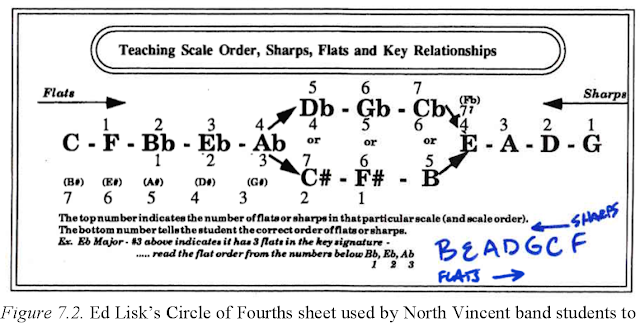Seasoned educators often provide valuable tips and recommendations for warm-ups. The real challenge is to not allow a daily warm-up turn into something that is so mundane that the student brain processes start to flat line. Today we are going to introduce ideas for warming up your band starting with the circle of 4ths.
Before we get started please consider referring to Robin Linaberry’s book, “Strategies, Tips, and Activities for the Effective Band Director, Targeting Student Engagement and Comprehension.” I found this book to be invaluable and serves as an excellent reference for today’s post.
Please checkout Mr. Linaberry’s website for an incredible amount of free resources at https://www.robinlinaberrymusic.com/. You can also purchase his book(s) here.
“More Ideas”
If you have read Ed Lisk’s book “The Creative Director : Alternative Rehearsal Techniques,” you have learned that the book teaches us that students can achieve more when provided a specific sequence of steps toward well-defined goals. Lisk’s core method for this approach of teaching includes the circle of 4ths.
Although, we are not going to thoroughly cover everything in this method it is also wise to add this book to your list of pedagogical readings.
The Circle of Fourths
To start this process, begin by first posting graphics of the Circle of 4ths (or otherwise called the Circle of 5ths) to you music room walls. Posters and pdfs of the Circle of 4ths are generally easy to find online or within method books.
In Lessons
The next step is to use the Circle of 4ths graphic in your lessons. As a music educator, you want to be able to clearly explain the order of the flats and sharps as they pertain to their key signatures. Guide students to an understanding of how the keys progress from one to an other. And most importantly, clearly explain what an enharmonic is.
From this foundational point of understanding you can incorporate the Circle of 4ths in your warm-ups by adding theory lessons to your procedures. This will help keep things fresh and mentally stimulating in your warm-up rehearsals.
Adding Activities
Keep things simple as you start to introduce the Circle of 4ths. Begin by verbally saying the name of the keys in order based on flats or sharps. For example, Starting with the flats I would progress from the key with zero flats to seven flats. (C (0b) – F (1b) – Bb (2b) – Eb (3b) – Ab (4b) – Db (5b) – Gb (6b) – Cb (7b.) In contrast, starting with the sharps I would progress from the key with zero sharps to seven sharps. (C (0#) – G (1#) – D (2#) – A (3#) – E (4#) – B (5#) – F# (6#) – C# (7#.)
Figuring Out Keys
Once the ensemble is capable of understanding the basics of the order of flats and sharps, what scales have which accidentals, understanding the basics of scale degrees within the scale (which also includes solfege) then they need to be able to determine the keys of major scales from a visual stand point.
For instance, for sharp keys the last sharp in the visually represented key signature is the 7th scale degree on “Ti” in solfege. Go up 1/2 half step from this last sharp and the name of the note that is on the line or space is the name of the major scale.
For flat keys, the last flat is the 4th scale degree or “Fa.” Countdown 4 – 3 – 2 – 1 (or Fa-Mi-Re-Do) to determine the name of of the major scale. An other option is to look at the second to last flat in the key signature to determine the name of the major scale. However, you should note this only works with flat scales.
The next logical thing is to be able to determine the key signature when you know the name of the key or scale. To do this:
- First determine if the scale is a flat or sharp scale. Remember that the key of “F” is the only flat scale that does not have flat (b) in its name.
- Second, Use the musical alphabet to build the scale up without accidentals. For example, A-B-C-D-E-F-G-A.
- Next if the scale is a flat key, recall that last flat is the 4th scale degree (or Fa). Add a flat to the 4th note which is Db in this case. (A-B-C-Db-E-F-G). Now using the “Order of flats” (remember Bb-Eb-Ab-Db-Gb-Cb-Fb) simply go in order and add the flats until you reach the 4th scale degree. In this example it will be Ab–Bb-C-Db-Eb-F-G-Ab.
- Now if the scale is a sharp key, remember that the last sharp of the key is the 7th scale degree (or Ti.) So you will add a sharp to the 7th note which is G# in this case. (A-B-C-D-E-F-G#-A). Next, using the order of sharps (which is the opposite of the order of flats: F#-C#-G#-D#-A#-E#-B#) simply add the remaining sharps in order until you reach the 7th scale degree. In this example it will be A-B-C#-D-E-F#–G#-A.
Guidelines for Figuring Out Transpositions
Figuring out transpositions can be a confusing subject for some if you don’t keep things simple. Here are some basic guidelines for doing just that.
“C” instruments are “concert” instruments. That means that when they are asked to play the Concert “A” major scale, they play their “A” scale. in other words, A-B-C#-D-E-F#-G#-A.
“F” instruments such as French Horn and English Horn play a Perfect 5th above the concert key. This means to subtract 1 flat (b) or add 1 sharp (#). Those players will look to the Circle of 4ths and A concert will transpose to E concert.
“Bb” instruments such as trumpets, clarinets and tenor saxes play a whole-step above the concert key. This means to subtract 2 flats (b) or add 2 sharps (#). Those players will look to the Circle of 4ths and A concert will transpose to B concert.
“Eb” instruments such as alto saxes, and baritone saxes play a major-sixth above the concert key. This means to subtract 3 flats (b) or add 3 sharps (#). Those players will look to the Circle of 4ths and A concert will transpose to F# concert.
Work Through With Students
Work through the content with your students. Do this by speaking through the process of each key. Be sure to have graphics easily visible to your students. Choose a key such as Eb major. Speak through it such as: “E flat major has three flats: Bb, Eb and Ab.
Once you feel students understand how to transpose from concert pitch to their instrument try some of these “Circle of Keys” strategies:
#1 Play Around the Circle
Start with “Play Around the Circle” by playing a unison “C” concert in whole notes. After one measure move to concert F, then Bb, then Eb, and so on. Be sure students know how to get through the enharmonic keys. Start simple with long tones but then extend to varying note values, rhythms, meters, and articulations.
#2 Play Partial Scales in Each Key
Playing in small scale portions can help illustrate relationships within the Circle of 4ths while at the same time helping students learn tetrachords (first 4 notes of a major scale.) It is recommended, at this stage, to avoid using formal notation but rather use verbal instruction, call-and-response, Kodaly hand sings or any other method. Carefully transition each partial scale sequence by leading it to the next key.
#3 Play Two Adjacent Keys Simultaneously
Split up the band into two groups. Decide on a chosen melodic figure that is based on an open 4th or 5th relationship. Start by playing in these two keys (consider concert Bb and F.) Use this opportunity to have students work on beatless tuning and any other musical element.
#4 Build Chords
Listening skills is one of the “big list” items music educators set out to improve on within their ensembles. When directors work on chord qualities, students learn to improve their listening skills. For example, Linaberry identifies you should have three groups assigned to play in the keys of C, Eb, and G to hear a minor triad. Have groups move around the Circle of 4ths to hear each of the other minor triads.
Consider building any series of triads, seventh chords, and other tonal sonorities while apply balance, blend and tuning concept analysis.
#5 Target Specific Chords from the Concert Repertoire
Search in your concert music for a problematic chord to analyze. Then reduce it to its basic root position. Use the previously practiced #4 Build Chord exercise to listen around the circle of 4ths. When the ensemble arrives back to the original key and is sustaining the chord with a beautiful sound, send players back to the chord as scored in their musical composition.
Urge your student musicians to transfer the same beautiful sound, they played in the closed position, back to the expanded scoring in the literature.
Conclusion
The Circle of Fourths provides an excellent platform to keep ensemble warm-ups goal driven and productive. By starting simple and slowly expanding a student’s knowledge base, they are able to learn the relationships of scales and keys deeper- with greater understanding. Music is similar to a pyramid. It needs a strong foundation. Create building blocks of knowledge to build upon this foundation. Take this advice as a means for developing a deeper understanding into how you and your students think about foundational melodic and harmonic relationships.
Sources
Linaberry, R. (2021). Strategies, tips, and activities for the effective band director: Targeting student engagement and comprehension. Routledge.
Lisk, E. (1993). The creative director: Alternative rehearsal techniques. Meredith Music Publications.






